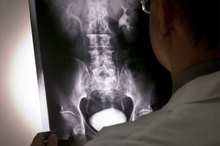Pain From Sleeping Positions
The wrong sleeping positions can affect your whole body, causing immediate pain and long-term damage. Poor sleep posture interacts with existing conditions, such as shoulder injuries and osteoarthritis, to make them worse. Improper spinal alignment can affect the muscles, joints, organs and nerves and cause back and neck pain, as well as remote body pain. This situation can, however, be prevented and cured by attention to how you position your body in your sleep environment.
Identification
The Cleveland Clinic and National Sleep Foundation list possible sleep reasons for neck or back pain as having too little room in bed, curling too tightly for internal organ comfort and improper body alignment. Sleeping on your stomach, even for short periods, can result in back and neck pain because of the exaggerated position of the cervical and thoracic spinal curves. If this position feels comfortable, your standing posture might be causing too great an arch in your lower back, a condition called lordosis that is often responsible for neck pain.
Misconceptions
The Best Kind of Mattress for Spinal Stenosis
Learn More
A firm mattress might not offer the best support for everyone. The Cleveland Clinic notes that your body type plays a part in whether the mattress conforms to your body or vice versa. Hourglass figures do better with a softer mattress that better absorbs the proportional weight of your pelvis. People with a less pronounced waist enjoy better alignment with a firmer mattress. Likewise, a soft pillow might give inadequate neck and shoulder support.
Solution
Realigning your spine in bed can afford immediate relief from neck and back pain. The American Chiropractic Association suggests using an orthopedic pillow that encourages proper neck sleeping position. It should be thicker for side sleepers and thinner for back sleepers. Some pillows are designed to accommodate both. Additionally, you can alleviate back pain when sleeping on your side by placing a small pillow between your knees. If you sleep on your back, placing a longer pillow under your knees will reduce the pressure on your cervical and thoracic areas.
Standing Posture
Sleeping & Tense Muscles
Learn More
The American Physical Therapy Association suggests checking your standing posture for its impact on your sleeping position and back pain. Stand against a wall with one arm behind your head, palm toward your neck. Place the other arm behind the lumbar curve of your lower back, palm to the wall. If you can freely move your hands in this position, you should have your posture evaluated by a chiropractor or doctor. Abdominal and other exercises often serve to correct poor posture habits.
Warning
A sudden, disabling, shooting back or neck pain, numbness or tingling might indicate a sudden compression fracture or one that impinges nerves. You should seek a doctor’s diagnosis regarding the severity of any vertebral fracture.
Related Articles
References
Writer Bio
Nancy Clarke began writing in 1988 after achieving her Bachelor of Arts in English and has edited books on medicine, diet, senior care and other health topics. Her related affiliations include work for the American Medical Association and Oregon Health Plan.







